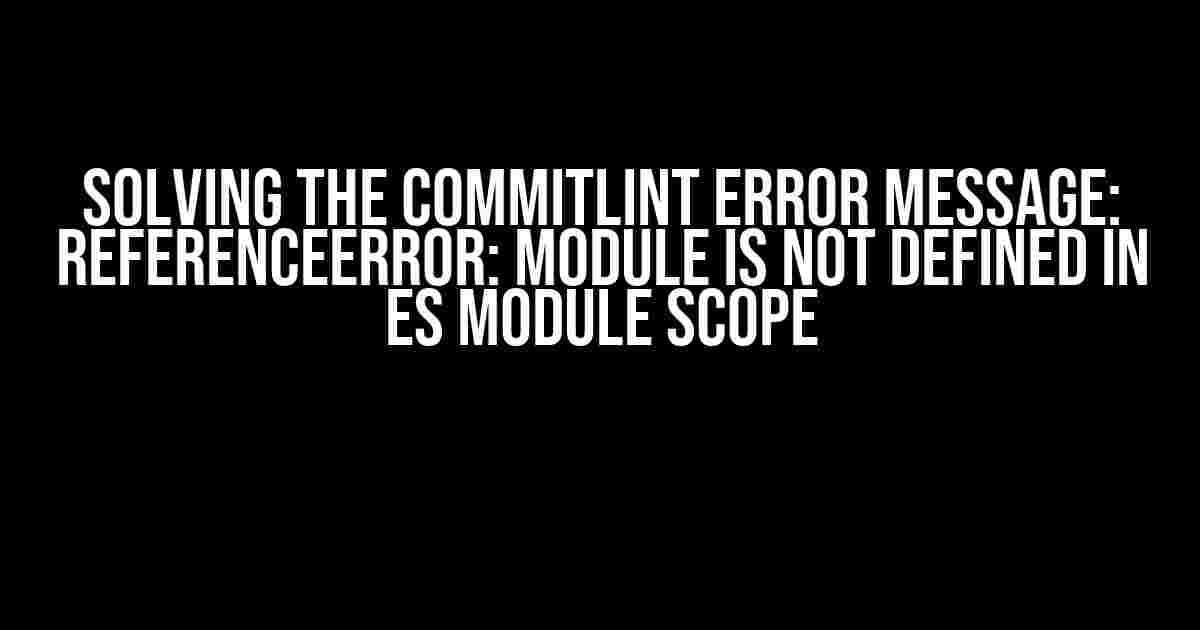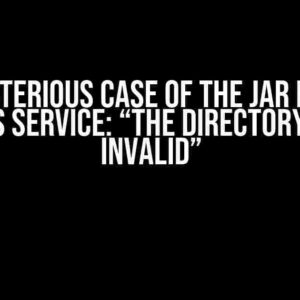Are you tired of staring at the Commitlint error message “ReferenceError: module is not defined in ES module scope” without knowing what to do next? Don’t worry, you’re not alone! In this comprehensive guide, we’ll delve into the world of Commitlint, explore the reasons behind this frustrating error, and provide step-by-step solutions to help you overcome it.
What is Commitlint?
Commitlint is an impressive tool that enables you to enforce a consistent commit message format across your project. It’s a part of the Husky ecosystem, which makes it easier to manage and maintain your Git hooks. With Commitlint, you can define custom rules and checks to validate your commit messages, ensuring that they conform to your project’s specific guidelines.
What is the Commitlint error message “ReferenceError: module is not defined in ES module scope”?
The error message “ReferenceError: module is not defined in ES module scope” typically occurs when Commitlint encounters an issue with your commit message format or configuration. This error can be triggered by various factors, including:
- Invalid or missing configuration files (e.g., commitlint.config.js)
- Incorrectly formatted commit messages
- Incompatible versions of Node.js or ES modules
- Conflicting dependencies or plugins
Common Causes of the Error
Before we dive into the solutions, let’s explore some common scenarios that might lead to this error:
1. Missing or Incorrect Configuration File
In many cases, the error occurs due to a missing or incorrectly configured commitlint.config.js file. This file is responsible for defining the rules and checks for your commit messages. Make sure you have created the file in the correct location and that it contains the necessary configuration options.
module.exports = {
extends: ['@commitlint/config-conventional'],
rules: {
'scope-enum': [2, 'always', ['feat', 'fix', 'docs', 'style', 'refactor', 'perf', 'test', 'build', 'ci', 'chore', 'revert']],
},
};
2. Incompatible Node.js or ES Modules
The “module is not defined” error can also occur if you’re using an incompatible version of Node.js or ES modules. Ensure that you’re running the correct version of Node.js (at least v14.17.0) and that your project is configured to use ES modules.
3. Conflicting Dependencies or Plugins
Sometimes, conflicting dependencies or plugins can cause issues with Commitlint. Check your package.json file and remove any unnecessary or conflicting dependencies. Also, make sure you’re using the correct versions of plugins like husky and commitlint.
Solutions to the Error
Now that we’ve covered the common causes of the error, let’s move on to the solutions:
1. Create a commitlint.config.js File
First, create a new file named commitlint.config.js in the root of your project. Add the following configuration options:
module.exports = {
extends: ['@commitlint/config-conventional'],
rules: {
'scope-enum': [2, 'always', ['feat', 'fix', 'docs', 'style', 'refactor', 'perf', 'test', 'build', 'ci', 'chore', 'revert']],
},
};
2. Update Your package.json File
Add the following line to your package.json file to specify the type of module:
3. Install the Correct Versions of Dependencies
Run the following commands to install the correct versions of husky and commitlint:
npm install [email protected]
npm install @commitlint/[email protected]
4. Configure Husky to Use Commitlint
Add the following script to your package.json file to configure Husky to use Commitlint:
"scripts": {
"commitmsg": "commitlint -e"
}
5. Test Your Commit Message
Create a new commit with a correctly formatted message to test your configuration:
git add .
git commit -m "feat: my new feature"
If everything is set up correctly, you should see a success message indicating that your commit message conforms to the Commitlint rules.
Best Practices for Commitlint Configuration
To avoid future issues with Commitlint, follow these best practices for configuration:
- Keep your commitlint.config.js file up-to-date and in sync with your project’s guidelines.
- Use a consistent naming convention for your rules and checks.
- Test your Commitlint configuration regularly to ensure it’s working as expected.
- Document your Commitlint configuration and rules for future reference.
Conclusion
In this comprehensive guide, we’ve explored the Commitlint error message “ReferenceError: module is not defined in ES module scope” and provided step-by-step solutions to overcome it. By following the instructions and best practices outlined in this article, you’ll be able to configure Commitlint correctly and ensure consistent commit messages across your project. Remember to stay up-to-date with the latest versions of Node.js, Husky, and Commitlint to avoid compatibility issues. Happy coding!
| Keyword | Description |
|---|---|
| Commitlint | A tool for enforcing consistent commit message formats |
| ES module scope | A JavaScript module system used in modern browsers and Node.js |
| Husky | A tool for managing Git hooks and configuring Commitlint |
| Node.js | A JavaScript runtime environment for executing server-side code |
By following the instructions and best practices outlined in this article, you’ll be well-equipped to handle the Commitlint error message “ReferenceError: module is not defined in ES module scope” and ensure consistent commit messages across your project.
Frequently Asked Question
Got stuck with the infamous “Commitlint error message: ReferenceError: module is not defined in ES module scope”? Worry not, friend! We’ve got you covered with these 5 FAQs that’ll get you back on track in no time.
What does the “module is not defined in ES module scope” error mean?
This error occurs when Commitlint, a tool that enforces commit message conventions, is trying to execute code that relies on the `module` object, which is not available in ES module scope. It’s like trying to find your favorite snack in a store that doesn’t carry it – it’s just not there!
Why is Commitlint throwing this error in the first place?
Commitlint is designed to work with CommonJS modules, but it’s being forced to run in an ES module environment, which has different rules and behaviors. It’s like trying to put a square peg into a round hole – it just won’t fit!
How can I fix this error and get Commitlint working again?
You can fix this error by ensuring that Commitlint is running in a CommonJS environment. You can do this by adding the following line to your `commitlint.config.js` file: `module.exports = {-env: ‘commonjs’}`. This tells Commitlint to use the CommonJS environment, where the `module` object is available.
Will this error affect my code’s functionality?
No, this error is specific to Commitlint and won’t affect your code’s functionality. Your code will continue to work as expected, but you won’t be able to enforce commit message conventions with Commitlint until you fix this error.
Where can I learn more about Commitlint and ES modules?
For more information on Commitlint, check out the official documentation at commitlint.js.org. For a deeper dive into ES modules, head over to the Mozilla Developer Network at developer.mozilla.org.




